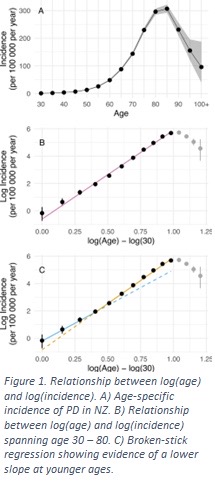 VOLUME 26, ISSUE 4 • DECEMBER 2022 Full issue »
VOLUME 26, ISSUE 4 • DECEMBER 2022 Full issue »

Top Research Article, Movement Disorders
A multistep model of Parkinson’s disease pathogenesis
Despite significant advances in our understanding of the aetiology of Parkinson’s disease (PD) spanning genetics, environmental exposures, infectious triggers, metabolic disruption and inflammatory and vascular contributions, an overarching framework for how the disease develops is lacking. Furthermore, basic observations such as incidence and prevalence differences between males and females do not have satisfactory explanations. A key question is whether the epidemiology of PD – and specifically how incidence varies with age – can tell us something fundamental about its pathogenesis. One possibility is that PD develops as a multistep process, involving cumulative, discrete events occurring over time and eventually leading to the development of the entity we recognise as Parkinson’s. If such a multistep process exists, then a linear relationship should exist between log(age) and log(incidence), with the slope of this line one less than the number of steps required for disease development. This model, termed the Armitage-Doll Model, has been extensively explored in the cancer literature and more recently applied to Amyotrophic lateral sclerosis.
In this study, we aimed to test the hypothesis that PD age-specific incidence is consistent with a multistep process, and to determine the number of discrete steps required to develop the disease. We then applied the multistep framework to three specific questions:
-
Is there evidence of a lower slope (and step number) at younger ages, which would be consistent with the greater contribution of genetic factors in those with younger-onset PD?
-
Do log-incidence curves for males and females differ in a manner consistent with varying environmental exposure effects or fundamentally different pathogenic mechanisms?
-
Can extensions of the basic Armitage-Doll model explain the observed fall in PD incidence at very old ages?

We used a validated probabilistic modelling process, based on medication prescribing, to generate nationwide age- and sex-adjusted PD incidence data for New Zealand, spanning 2006-2017. Models of log(incidence) versus log(age) were compared using Bayes factors, to estimate (1) if a linear relationship was present (indicative of a multistep process); (2) the relationship's slope (one less than number of steps); (3) whether slope was lower at younger ages; and (4) whether slope or y-intercept varied with sex. Finally, extensions of the basic Armitage-Doll model were compared to determine if the fall in PD incidence at very old age was best explained by a competing age-related process, or depletion of an initial pool of people who could ever develop Parkinson’s disease.
Across >15,000 incident cases of PD, there was a clear linear relationship between log(age) and log(incidence). Evidence was strongest for a model with an initial slope of 5.2 [3.8, 6.4], an inflexion point at age 45, and beyond this a slope of 6.8 [6.4, 7.2] There was evidence for the intercept varying by sex, but no evidence for slope being sex-dependent. A model with an initial pool of people (11% males, 7% females) who could ever develop PD best explained the observed late-age decline in incidence. The work shows that the age-specific incidence of PD is consistent with a pathogenic process that develops in multiple, discrete steps – on average six before age 45 and eight after. The model supports theories emphasizing the primacy of environmental factors in driving sex differences in PD incidence, whilst also suggesting that only a proportion of the population are susceptible to ever developing Parkinson’s disease. The multistep model may form a unifying framework within which ongoing research on pathogenesis can be understood.
The MDS Podcast delved more into this paper and its processes in an interview with the author:

Read more Moving Along:






